Employee Engagement Best Practices: How to Drive an Innovation Culture
Engaged employees become brand ambassadors. And employee engagement is important because it affects nearly every essential aspect of your company, including customer experience, employee turnover, profitability, and more.
Developing practical employee engagement practices is crucial and you have to get it right. Only 36% of American employees are engaged at work according to Gallup.
Additionally, in this digital age of new business models centered on hybrid and remote work, employee engagement is crucial to keep all your employees engaged and happy.
What is Employee Engagement?
Simply put, employee engagement is a concept that describes the relationship between employees and their employer and how invested they are in the business's success and their everyday work.
According to a 2020 report by Gallup on employee engagement and performance, organizations with higher employee engagement strategies saw a reduction in negative outcomes — such as low turnover and absenteeism — and a big boost in organizational success.
Results showed that organizations with high employee engagement had 23% higher profitability and productivity, and 18% more in sales.

All that is to say: Focusing on building a more engaged workforce is an investment worth making for every business.
What Is an Employee Engagement Strategy?
Employee engagement is essential, but it's not always simple.
It’s a plan that documents how your company will engage its employees. You should outline the following in your employee engagement strategy:
-
Ways to measure engagement — whether through email, employee engagement surveys, or indicators such as productivity and turnover
-
Clear engagement goals
-
Your budget
-
Clear practices for improving engagement (this can include any of the strategies which we’ll discuss in this post
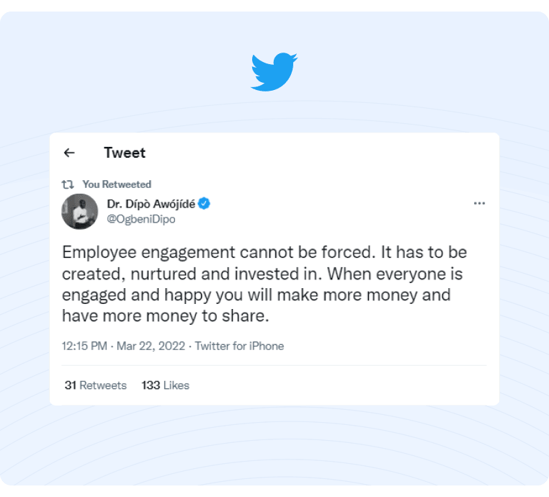
To help you keep all your staff engaged, here are 12 employee engagement strategies to get you started.
1. Offer Regular, Constructive, and Sincere Feedback
Employees have questions, ideas, and concerns, and they want to be heard. Frequent feedback results in increased employee engagement.
Employees who get feedback from their managers daily are three times more likely to be engaged compared to those who receive feedback at least once a year, according to a Gallup study.
Also, feedback isn’t always positive. It should be honest, expressing what they’re doing wrong (or right) in their tasks and what they might need from you to better support them. Don’t be quick to fire them without helping them first.
 According to Logan Mallory, Vice President of Marketing at Motivosity, “managers need to remember that giving feedback is a conversation, not an interrogation. They need to leave time for the employee to ask questions and share their feedback as well. They shouldn’t overwhelm the employee with information. Make sure the conversation is paced well and leaves time for the employee to process and react to what they’re being told.”
According to Logan Mallory, Vice President of Marketing at Motivosity, “managers need to remember that giving feedback is a conversation, not an interrogation. They need to leave time for the employee to ask questions and share their feedback as well. They shouldn’t overwhelm the employee with information. Make sure the conversation is paced well and leaves time for the employee to process and react to what they’re being told.”
To effectively give feedback to your employees, give them a modern tool like Slack to express their concerns, conduct weekly formal performance reviews, and hold monthly all-hands company meetings.
2. Provide Opportunities for Continuing Education, Learning, and Development
Employee engagement is more than making your employees love their jobs — it’s about having policies in place that supports their professional development.
“I find the best way to improve employee engagement is by providing growth opportunities. Employees are more likely to stay with you if they have room for personal development and promotion within the company, both internally and externally, via training programs or other partnerships outside of work hours where it can still count towards their career goals,” Amit Raj, CEO of The Links Guy recommends.
You can support your employees' career growth by providing job shadowing, mentoring, and succession programs.
3. Develop Human Connections with Your Employees
Often times there is a deep disconnect between upper management and lower-level employees but there doesn’t need to be.
Develop friendly, human connections with your team members. You’ll find that your employees are more receptive to leaders who they can have a normal and easy conversation with.
According to Agata Szczepanek, community manager at MyPerfectResume, “the human-centered approach pays off. The more you value people, the more engaged they are. Focus on little things which make the workplace brighter. For example, did one of your employees just become a parent? Buy their baby a little gift. Valentine’s Day? Leave heart-shaped cookies next to the coffee maker.”
You can develop a friendly connection with your staff by:
- Simply wandering around the office, randomly chatting with them, and getting to know what they’re struggling with (this can also be done in Slack channels or on Zoom calls). Also, share with them what you’re struggling with and ask for their advice.
- Did they recently take advantage of your wellness program, like paid time off? Ask if they enjoyed the time away. Likewise, if they are not taking advantage of a wellness program item, draw their attention to it.
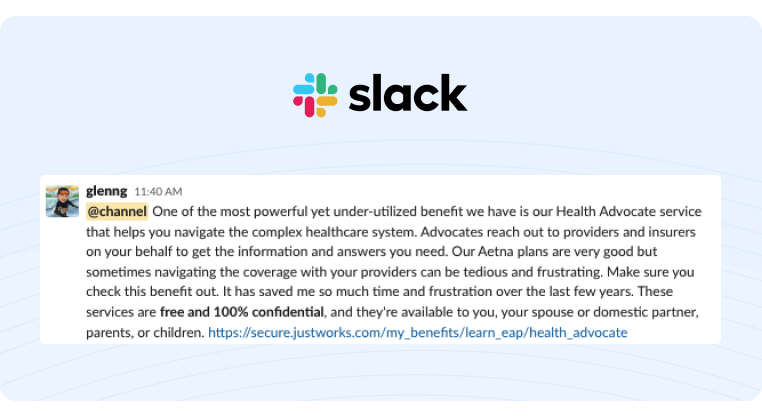
- Encourage shared employee engagement activities with icebreaker questions, icebreaker games, or a company book club for example.
4. Prioritize Employees' Wellness, Benefits, and Health
The connection between employee wellness, health, and employee engagement is obvious: healthier and happier employees are more engaged in their workplace and work than employees battling health, nutrition, and sleep issues.
To nail knowing how you can help your employees achieve wellness, it’s best to:
Focus on Whole Wellness
This means you shouldn't only focus on physical wellness, like offering gym memberships. Research from Quantum Workplace shows that physical, emotional, and financial wellness are all interrelated. So, it's best if you try to cover those three wellness areas.
“For employee wellness, we’ve had great success building a company-wide mindfulness practice. Mindfulness can be instrumental in helping to improve employees’ overall mental health. It provides them with tools to cope during stressful situations, regulates their emotions during tense times, and become more in tune with their stress levels to be able to manage them before they get out of control” adds Mark Pierce, CEO at Cloud Peak Law Group.
Offer Work-Life Benefits
According to research from SHRM, more than 70% of employees choose PTO (paid time off) as an important work-life benefit when applying for a new job.
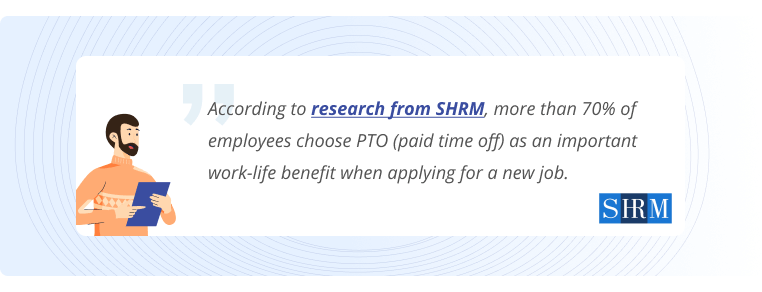 Offering PTO is table-stakes; review how to best leverage PTO as a company. It might look like unlimited PTO, it may be company-wide closures to ensure everyone is resting, or perhaps it's half-day Fridays in the summer.
Offering PTO is table-stakes; review how to best leverage PTO as a company. It might look like unlimited PTO, it may be company-wide closures to ensure everyone is resting, or perhaps it's half-day Fridays in the summer.
Employees look for the extra benefits, too. Depending on the industry or location, a company car or commuter plan may be advantageous; for others, it may be stock options or flexible work schedules. Those little things that make an employee appreciate you can also be what attracts them to you.
Lastly, if you’re still figuring out the benefits you should offer your employees, align your company values with the benefits. For example, if your company focuses on appreciating the outdoors and nature, it makes sense to give your employees days off to go hiking, camping, etc.
5. Perform a Manager Check-in Task After the First Year
Employee engagement is usually high in the beginning but it declines after one or two years of an employee working at your organization, according to Quantum Workplace.
Keep your employees happy and engaged by scheduling a one-with-one and asking:
-
What is their experience with the company so far?
-
How can the company help them do their jobs better?
-
What new skills related to their work would they like to learn?
-
Where do they see their career going and how can the company help them?
Dig into these answers and schedule a follow-up to discuss these points regularly.
Asking these questions helps you gauge your employee engagement activities and you get to understand changes you need to make to ensure high employee retention.
6. Create Company Recognition Programs
Employee recognition is the foundation of every employee engagement practice. We humans like to feel appreciated for doing a good deed. The same applies to acknowledging your employees for their efforts.
According to a 2019 report by Bonusly, 84% of engaged employees got recognition for their work compared to 25% of disengaged employees.
Recognition also creates a good relationship between your fellow employees.
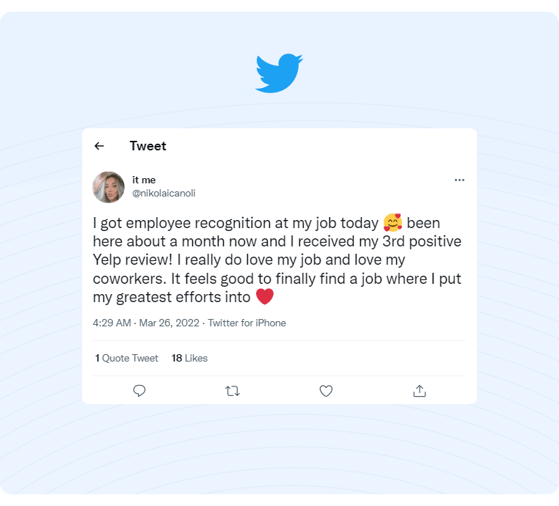 To improve your recognition programs, you can:
To improve your recognition programs, you can:
- Ask for peer-to-peer recognition
- Make it public. Your employees will be happy to see their efforts being recognized by everyone in the company. For example, ours lives on our internal Slack channels and is open to everyone in the company.
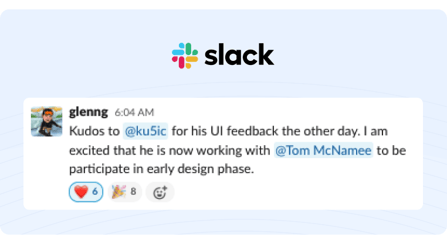
- Give your employees holiday rewards
- Publicly promote your employees on your social channels
Remember, saying only “thank you” is not enough for an employee who went above and beyond in their work.
7. Encourage Flexible Working Arrangements for Your Teams
According to this 2020 study by ProQuest, flexible work environments have an impact on employee engagement. With flexibility, ensure you’re coming up with policies that favor both hybrid and remote working.
Not sure where and how to start? These strategies will help you get started:
Talk to Your Employees
Get to know what your employees need to accomplish their best work. Start with a short employee survey. It’s unfair for you to come up with flexible working policies without involving your current employees.
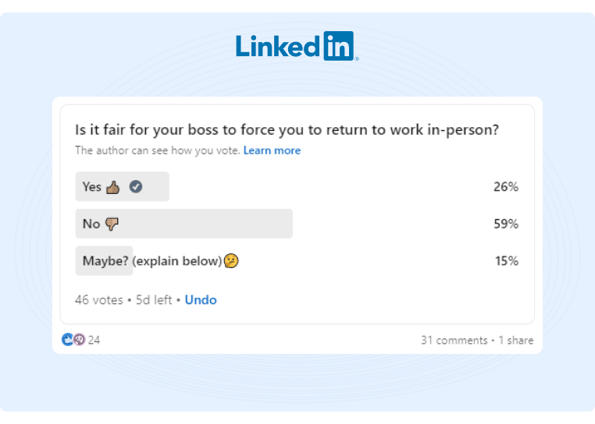 Start by asking your managers to have discussions with their teams and to share their feedback on what’s working and what’s not. Create a safe environment and let your teams give suggestions on what they think would work.
Start by asking your managers to have discussions with their teams and to share their feedback on what’s working and what’s not. Create a safe environment and let your teams give suggestions on what they think would work.
Remember, Flexibility Isn't Only Where Your Employee Works
It’s easy to forget other dimensions of work flexibility when everything currently centers on working from home and working at the office — try to offer your staff flextime.
Remind them they have a life outside of work. For example, let them know it’s okay to even pick up their children from school during work hours as long as the work gets done.
Furthermore, always record meetings so that employees can catch up if they cannot be present for the entire meeting.
8. Establish Solid Employee Advocacy Programs
A 2020 study found that employee advocacy can improve employee engagement. It’s an excellent strategy to engage your employees while also promoting your brand.
Here’s how you can get started:
Give Every Employee a Voice
Give your employees freedom to create their content and not just to echo your corporate voice. Get their feedback to know the type of content they would like to share, and where they want to share it.
Make it Completely Voluntary
Don’t force your employees to share your company’s content on their personal social media accounts. You can offer them incentives through gamification for sharing your content but it should always be voluntary.
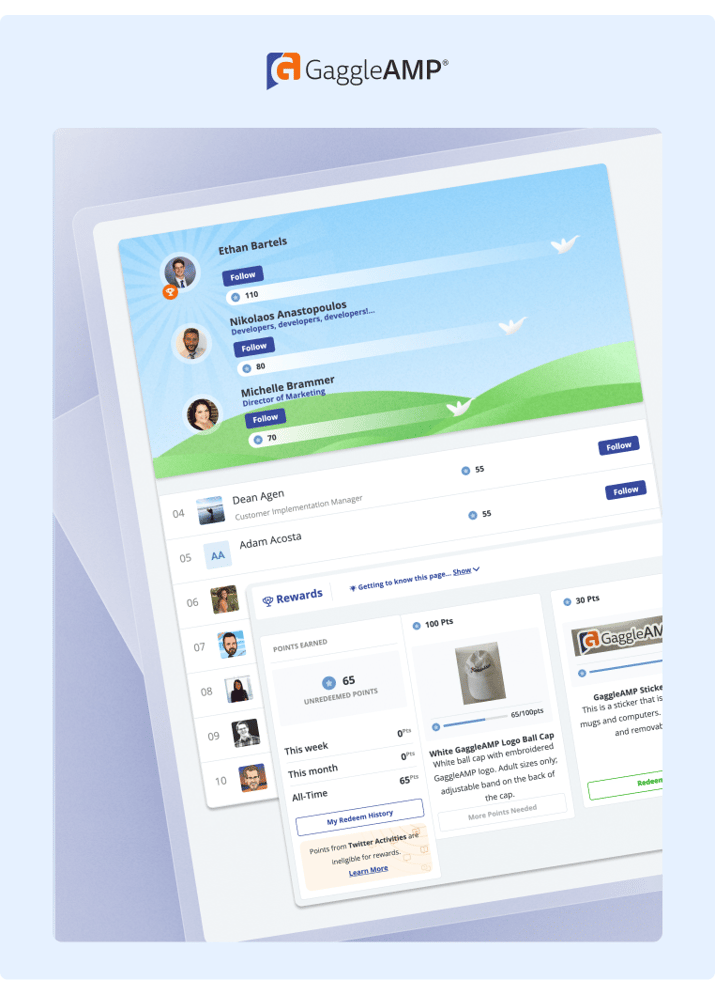
By using an employee advocacy platform like GaggleAMP, you can assign any amount of points you want to certain activities that you’d like for your employees to do. Those points can then be redeemed with the Gaggle Manager for company swag, gift cards, meals with senior leaders, and more.
9. Establish a Transparent Work Environment
It’s the trust between you, your business leaders, and your employees that will keep everything running smoothly in your company.
When you show your employees that you trust them with important details in the company, they feel engaged and important, and this increases the employee life cycle.
Be transparent with them on almost all company information, even salary information. For example, many organizations are now introducing pay transparency to ensure you, and your team members, are paid fairly for your talents, not just where you live or your gender.
But transparency goes beyond being honest — it means creating communication channels and systems that make it easy for your employees to get the information they’re looking for.
Moreover, trust improves your relationship with your employees and removes the hierarchical divide — it puts you all on a level playing field.
10. Create Diversity and Inclusion Programs
When your staff feels included, they’re more engaged with their work and your company.
A Mckinsey report found that companies with both gender and racial diversity enjoy 46% higher financial performance than those without.
 It’s important to note that diversity isn't just about race. It’s about embracing different genders, ages, financial backgrounds, personalities, education backgrounds and so much more.
It’s important to note that diversity isn't just about race. It’s about embracing different genders, ages, financial backgrounds, personalities, education backgrounds and so much more.
Diversity should be addressed at every step of your employee engagement program.
To ensure you enhance diversity and inclusion to improve employee engagement levels in your company, try these ideas:
- Create hiring and mentorship programs, especially for people from unrepresented backgrounds
- Celebrate different events and holidays
- Build an inclusive workplace, e.g. make your building accessible for disabled employees
- Create strong anti-discrimination policies. For example, if an employee gets mocked in the workplace because of their race, what policy do you have in place?
Lastly, to cultivate a truly inclusive culture and have happy employees, make sure your employees recognize each other. For example, if you have employees in different countries, try to get together once per year or even respect their timezone differences.
11. Build a Solid Onboarding Process
Employee engagement initiatives should always start with a good onboarding process.
Research from Gallup shows that employees who had a good onboarding process are 2 times more likely to be satisfied with their employer.
You can improve engagement during the onboarding process by:
- Giving your new staff members an onboarding buddy to help them understand how your organization operates
- Making sure the new hires know their goals and how they contribute to the success of your company
- Let your new employees know your expectations and the process you use for job promotions
- Have them meet up with their leadership team to know who they’ll be reporting to. This might include their direct manager, CEO, and department head, for example
- Ensure they have access to all tools or login criteria to any platforms relevant to their role
12. Create a Good Company Culture
Company culture plays a big role in employee engagement, like increasing employee productivity.
The first step towards developing a strong organizational culture — one that can lead to strong engagement, is to document it. To make it simple, work with your leaders across all departments to define:
- Your company's vision, mission, and values
- Expectations about employee behaviors
According to a 2020 culture report from Achievers, employees are more likely to be engaged at work when the company values are well-aligned with their personal values.
Sarah Jameson, the marketing director at Green Buildings Elements says “Forming a team that focuses on company culture and values can help your team feel valued. At Green Building Elements, we have a dedicated group of people that help us evaluate culture-related activities and business processes and whether they align with our company's core values. This helps in making sure everyone is held accountable for executing their roles at work which puts company values at the center.”
Establishing employee engagement best practices can feel overwhelming sometimes so it’s best to start small and build over time We’d recommend you focus on the aspects that you feel can solve your company’s unique engagement struggles and increase your employee morale first and then layer in other techniques and programs.







